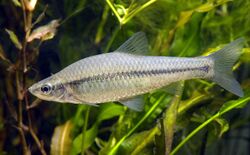Biology:Stone moroko
| Stone moroko | |
|---|---|

| |
| Scientific classification | |
| Domain: | Eukaryota |
| Kingdom: | Animalia |
| Phylum: | Chordata |
| Class: | Actinopterygii |
| Order: | Cypriniformes |
| Family: | Cyprinidae |
| Subfamily: | Gobioninae |
| Genus: | Pseudorasbora |
| Species: | P. parva
|
| Binomial name | |
| Pseudorasbora parva (Temminck & Schlegel, 1846)
| |
| Synonyms | |
| |
The stone moroko (Pseudorasbora parva), also known as the topmouth gudgeon, is a fish belonging to the Cyprinid family, native to Asia, but introduced and now considered an invasive species in Europe and North America. The fish's size is rarely above 8 cm and usually 2 to 7.5 cm long.[2]
Invasive species
In Europe, P. parva is included since 2016 in the list of Invasive Alien Species of Union concern (the Union list).[3] This implies that this species cannot be imported, bred, transported, commercialized, or intentionally released into the environment in the whole of the European Union.[4]
The fish was introduced in the 1960s into ponds in Nucet, Dâmbovița County, Romania and it made its way into Danube, then spreading throughout Europe. These fish feed on eggs of locally valuable native fish species.
Four phylogenetic lineages of Pesudorasbora parva were identified within its native range, and three of them contributed to the dispersal within more western regions of Eurasia. One of these lineages was initially distributed in the north of China and the Far East of Russia, the second one was in southern China, the third one was in the Korean Peninsula and, probably, in the adjacent regions of China, and the fourth in Taiwan. Geographical distribution of COI lineages suggests three donor regions of stone moroko invasions into more western regions of Eurasia: the basin of the Yangtze River, the northern (Russian) part of the Amur River basin, and the Sungari River basin (right tributary of the Amur in the territory of China).[5]
The species has also been recently discovered in several lakes in the UK where it is believed to have been illegally stocked. This has called for a large scale eradication programme organised by the Environment Agency who kill the fish off with a piscicide called rotenone.
Parasites
Pseudorasbora parva poses danger to other species such as the sunbleaks (Leucaspius delineatus). These fish are the carrier of a parasite, the protist (Sphaerothecum destruens[6]) that is not damaging to the topmouth gudgeon, but attacks other fishes like the sunbleaks, which are unable to spawn and have a higher mortality when infected.[7]
A 2023 study showed co-introduction of three monogenean species, Dactylogyrus squameus, Bivaginogyrus obscurus, and Gyrodactylus pseudorasborae into Europe along with their fish host from East Asia. In addition to co-introduced parasites, the fish was infected with a local generalist, the monogenean Gyrodactylus prostae. Monogenean infections were generally lower in non-native host fish, potentially giving an advantage to this invading species.[8]
References
- ↑ Huckstorf, V. (2012). "Pseudorasbora parva". The IUCN Red List of Threatened Species: 2012: e.T166136A1114203. doi:10.2305/IUCN.UK.2012-1.RLTS.T166136A1114203.en.
- ↑ "Archived copy". http://www.environment-agency.gov.uk/static/documents/Leisure/Topmouth_gudgeon_fact_sheet.pdf.
- ↑ "List of Invasive Alien Species of Union concern - Environment - European Commission". https://ec.europa.eu/environment/nature/invasivealien/list/index_en.htm.
- ↑ "REGULATION (EU) No 1143/2014 of the European parliament and of the council of 22 October 2014 on the prevention and management of the introduction and spread of invasive alien species". https://eur-lex.europa.eu/legal-content/EN/TXT/PDF/?uri=CELEX:32014R1143&from=EN.
- ↑ Karabanov, D.P.; Kodukhova, Yu.V.; Pashkov, A.N.; Reshetnikov, A.N.; Makhrov, A.A. (2021). ""Journey to the West": Three Phylogenetic Lineages Contributed to the Invasion of Stone Moroko, Pseudorasbora parva (Actinopterygii: Cyprinidae)". Russian Journal of Biological Invasions 12 (1): 67–78. doi:10.1134/S2075111721010070. ISSN 2075-1125. https://www.researchgate.net/publication/350516644.
- ↑ Deadly Parasite Could Endanger Salmon And Trout Populations In U.K. Science Daily June 20, 2009
- ↑ "The Gudgeon and the Sunbleak", New York Times June 28, 2005
- ↑ Ondračková, Markéta; Seifertová, Mária; Tkachenko, Maria Yu.; Vetešník, Lukáš; Liu, Huanzhang; Demchenko, Viktor; Kvach, Yuriy (2023). "The parasites of a successful invader: monogeneans of the Asian topmouth gudgeon Pseudorasbora parva, with description of a new species of Gyrodactylus". Parasite 30: 22. doi:10.1051/parasite/2023024. PMID 37326471.

Wikidata ☰ Q583540 entry
 |


